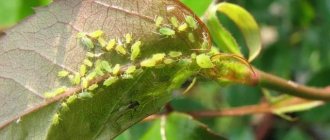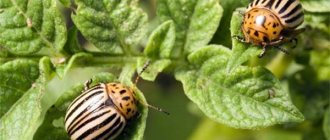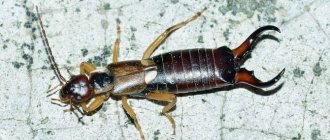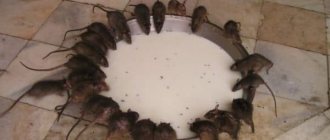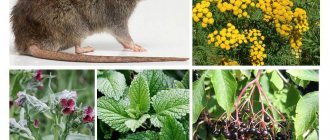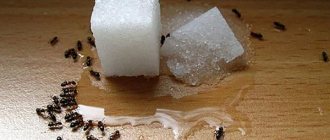Can ants and bees coexist?
In most cases, these insects live separately from each other, without intersecting in any way. Ants are considered useful arthropods and destroy predatory pests. If the number of their colony increases, the bees may be in danger. At first it is not too pronounced - the ants only cause discomfort by setting up nests in the hives. Gradually, the products of their vital activity accumulate here. The ants in the hive feed on honey, a sweet food, which is why the bees stop consuming this product.
Not all ants are harmless. Some of their varieties attack bees more often, even if the size of the colony is not large enough and there is no need to go in search of new sources of food and housing. Ants and the bee family are related - they belong to the same superfamily. But this does not stop them from resisting.
Tips and tricks for beekeepers
Experienced beekeepers are happy to give recommendations on how to deal with ants in a hive with bees. Here are some tips:
- Walk around the apiary area several times a season and remove any anthills that have appeared. They should not be at a distance of 80-120 m from the bees.
- Keep the area clean. Grass and bushes should be removed regularly.
- Repair the hive in a timely manner. If there are no mother-in-laws and cracks, then uninvited guests will have nowhere to settle.
- Do not scatter honeycomb remains on the site. This attracts ants.
- Dig a moat with water around the apiary. This will not only create a barrier for the ants, but also provide water for the bees.
Important! A strong bee colony can protect itself.
There are many means for killing ants in an apiary. It is up to the beekeeper to decide whether to use one thing or use different methods. However, you need to approach the issue of getting rid of ants wisely and not overdo it. You don't always have to get rid of them. In some cases, peaceful coexistence is quite possible.
Damage caused by ants
The main danger is the high probability of ants attacking bees. This can happen in an apiary where there are weakened colonies. Pests remove larvae and bee eggs from hives. The weakest individuals die. This is possible if the bee is sick. Ants gnaw through its abdomen to get to the crops, from which they can suck honey. Moreover, the weakest bee families are completely destroyed, especially in cases where large arthropods attack.
Ants can carry up to 1 kg of honey from a hive in 1 day . They damage bee products. Another danger is the high likelihood of contracting infectious diseases. Ants carry their pathogens on their outer surfaces. There is a risk of the spread of European and American foulbrood.
Destroy or defend
Ants appear when there is an invasion of insect predators. With such a neighborhood, the consequences can be different:
- the number of aphids and other pests is kept under control, which allows you to preserve the plants on the site;
- the danger to bees increases.
Experts do not recommend completely destroying ants. As a result, the number of other pests in the area near the apiary will increase. Then the crops and plants will die. More aggressive methods are used to expel garden and household arthropods from the site.
It is not recommended to fight forest ants; in this case, it is necessary to use deterrent methods to protect the hives.
Is it worth destroying
Before you start fighting ants, you need to determine the type of “robbers” and their location. Insects that live in the forest come to the hives only to have lunch. Garden ants are not averse to making their nest in the hives themselves: the house is not far, and the food is nearby. They usually prefer to settle in cracks between boards, under sheathing or in insulation. But red ants that live in human housing can occasionally visit for a treat.
On a note!
Do not forget that ants living in the garden and house are pests, while forest dwellers are classified as beneficial insects. Therefore, it is preferable that the fight against ants in the apiary is as humane as possible and does not involve casualties.
Use of chemicals
Select means to destroy Hymenoptera. Among the effective ones are:
- "Funaxin";
- chalk “Mashenka” (applied to hard surfaces);
- "Dohloks";
- "Ant-eater";
- supersulfate.
The last of the substances is a mineral fertilizer, but has a negative effect on pests. The legs of the hives and the paths along which the ants move are coated with chemicals.
Application of insecticides
If there are a lot of ants, then you can use more powerful products that are sold in specialized stores. Each product has instructions for use. It is very important to observe proportions and dosages. An excess of insecticides can kill bees (it is better not to use such poisons in the hive).
The Anteater product has proven itself to be excellent. This substance will quickly help get rid of the entire ant family in the entire apiary, which is ruining the apiary. The drug is highly effective in irrigating insects and baits for them. The substance does not linger in the soil, so other insects and microorganisms do not suffer. The drug is very economical, one package is enough for 5-10 anthills.
Superphosphate
Superphosphate, used by gardeners to fertilize beds, is suitable for destroying anthills. You need to throw a few handfuls of fertilizer onto the anthill. Within 5-7 days, both the adults and all the larvae will die inside it. This can be seen by ripping up the top of the nest.
Purchased chemicals
When buying anti-ant products, you need to remember: they belong to the same order as bees, so many chemicals are equally harmful to both. Therefore, you should carefully study the instructions and pay attention to the paragraph on precautionary measures.
- Fly tape. It is used to wrap the legs or base of the hive.
- Insecticidal chalk. Strips are drawn along the perimeter of the base or along the surface on which the hive stands, if possible.
- Contact insecticides in liquids, powders and aerosols. They are used to treat anthills and paths along which the ants go to the hives.
- Lures. They must be used carefully so that the bees cannot eat the poison.
Some beekeepers successfully use hexachlorane and dust to kill ants, spraying them along ant paths. But these products cause great harm to the environment and are unsafe for humans, so it is hardly possible to definitely recommend them for use in apiaries.
Getting rid of ants is difficult. For complete extermination, the anthill will have to be destroyed. It will be much more effective to scare them away from the apiary.
Important! Destroying anthills is prohibited by law according to Article 8.29 of the Code of Administrative Offenses of the Russian Federation.
From the chemical industry, Mashenka chalk will help in the fight against invaders. They coat the legs of the stand with it, but after each rain the procedure should be repeated. Contact agents have also proven themselves well. You can purchase special preparations for ants. After using them, within a week there will be no trace left of them.
- Anteater insecticide. It only works on ants and has become a real relief from them. Can be applied directly near the hives.
- The ant is produced in the form of granules, which should be dug into the territory of the anthill.
- Fitar is a paste containing the poison of a mushroom that is fatal to ants. A small amount of paste is applied to cardboard and placed near the home of the uninvited guests.
- Grom-2 - granules containing poison that blocks breathing. Scattered around the anthill. After 2 days the pests disappear.
- Bros is a ready-made powder that paralyzes the vital processes of ants. They need to sprinkle the anthill and insect paths. The action is almost instantaneous.
Methods for marking queen bees
You can use ultrasonic repellers and insect traps.
Important! Ants and bees belong to the same order. Many poisons affect them in the same way. All preparations should be used according to the instructions and placed in places inaccessible to bees.
Treating hive legs
Adhesive and viscous substances are used. They help keep pests out of the hive and save bees and honey. They are applied to the legs, so arthropods will not be able to crawl above the treated areas.
Solid oil
In order for the substance to remain in the lower part of the hive for a long time, it is necessary to treat the wood. The legs are filed and shallow grooves are made. Then they are filled with grease.
Vegetable oil
This method is used to protect beekeeping products that are in the public domain for ants. It is necessary to make a circular stroke along the circumference or perimeter of the container (cylindrical or square). The disadvantage of this method is the need to repeat the steps every day, because the oil dries out quickly.
Double sided tape
This is an auxiliary protective measure, because the adhesive strip will not be able to protect against pests for a long time - dust and other small debris stick to it. This method can be made more advanced. It is recommended to first wrap the legs of the hive with tape. A layer of glue is applied to the sticky surface, which does not dry out for a long time. The procedure is repeated every few days.
Animal fur
This method allows you to create an obstacle that is difficult to overcome. The fur is cut into long strips. They need to be secured to the legs of the hive. They use different methods: small nails, glue. An important condition is that the pile should be directed downwards.
Medical cotton wool
Prepare a strong-smelling, aggressive substance (acetone, kerosene). This liquid is applied to a small piece of cotton wool. The result is a repellent. The cotton wool needs to be secured in the area of the hive pegs. As the odor intensity decreases, the protective agent is renewed.
Treating the area around the hive
Bulk substances are used. Their fractions stick to the outer shell of the ant, which contributes to the appearance of discomfort in the pest.
Salt
The use of salt does not lead to death, but helps create unsuitable living conditions. The powder is placed around the hive and sometimes inside. It is also recommended to fill the anthill with salt if it is nearby.
Dry mustard
The product repels insects due to its bitterness. The properties of mustard are preserved for a long time, so there is no need to re-sprinkle the powder on the hive area. Small fractions, sticking to chitinous covers, interfere with movement.
Plants and spices against ants
Herbs exhibit properties that make it possible to create unacceptable conditions in the apiary for pests. Plants emit a specific and quite strong aroma, which repels ants. In addition, they contain components that cause discomfort, for example, essential oils and bitterness. But such a measure cannot be used as a main one due to its insufficiently high efficiency. However, it is considered as auxiliary when treating the area with other substances.
Cinnamon and other plants
It is recommended to plant the following flowers and herbs on the site:
- chrysanthemums;
- catnip;
- onion;
- garlic;
- sagebrush;
- tomatoes;
- parsley;
- valerian.
Cinnamon can be used. Spice sticks should be placed around the hive, near its legs. Onions are used using the same principle. It can be grown on the site, but additional bunches of green feathers are recommended to be placed in the hive, near the boxes with dry goods. As they dry, they are removed and a new portion is used. Moreover, to increase efficiency, feathers can be crushed.
Tomato leaves
The tomato tops are cut off and placed in the hive on canvas. A persistent odor appears that repels pests. Ants will not crawl inside if they smell the aroma of tomato leaves. The smell does not cause discomfort to bees and does not affect their productivity or vital functions.
You can grow tomatoes near the apiary. During the flowering period, conditions that are unacceptable for pests will naturally be created.
Traditionalist bees and social ants
Entomologist about insects: traditions and developed communications
On the air of “Radio Kuzichev” in Constantinople, entomologist, researcher at the Department of Entomology, Faculty of Biology, Moscow State University, Candidate of Biological Sciences Vladimir Kartsev. He explained the sociality of ants and bees.
insect family
Based on studying the behavior of ants, scientists draw conclusions and even predictions. For example, it is possible to predict an earthquake.
According to Kartsev, the ant community can be called a “family.” One or more females lay eggs, while young individuals and worker ants perform different functions, for example, bringing food and building a nest, caring for the female.
“It is precisely a social structure, because they are social in the sense that none of them can live alone. Neither the queen can live without workers, nor workers without the queen.”
Ordinary ants do not reproduce; they work until they die. Their hormone exchange is very complex; this process has been studied more in bees. The female secretes a mass of pheromones, or exohormones, which the workers lick, they exchange food from mouth to mouth (tropholaxis, from the word “trophos” - nutrition) and thereby at the same time transfer substances that the uterus secretes.
Bees have a similar principle. “In bees, if the queen is removed, the first thing they try to do is breed a new queen... But if this does not work out, then the bees - their ovaries will begin to develop without the influence of the queen, they will begin to fight among themselves, some of the bees will begin to lay eggs (the most successful). Only drones hatch from these eggs, because from unfertilized eggs, bees—and ants too—grow males,” Kartsev said.
Ant relationships: biting, police and dueling
Ants have a social hierarchy. Many people believe that the queen is the key link in the ant family, but this is not so. The main role is played by worker ants. They are the ones who control the life of the queen and have the right to move them from one part of the nest to another.
When a queen dies in a community, ritual battles begin among the workers to establish dominance. There are three types of relationships between ants - biting, police and dueling. Ants regularly exchange food - they feed each other. The well-fed feeds the hungry, who passes part of the food received to the next.
The functioning of each worker ant is aimed at ensuring the well-being of the family. For example, many ant families have a special group of carrier ants. All forms of ant grooming for each other are based on obligatory reciprocity or reward.
The interaction of individuals of different groups and ages is based on a hierarchical principle. Active foragers-scouts in different species not only detect food sources, but also act as guides for groups of passive foragers. It has already been proven that ants learn faster than all other insects in a maze; they distinguish figures well by their shape and are able to distinguish the number of angles when choosing the path leading to the feeder. It is also interesting that in natural settlements of ants, hunters of one species, dominant in the territory, use signals from scouts of other species to detect and capture the prey they find.
Not only do ants have a clearly established social order within the ant family, but they also wage so-called internecine wars, thus enslaving ants of other species and subsisting at the expense of their slaves. All these facts prove that ants are perhaps the creatures closest to humans in their social organization, and few people know that these small insects are much smarter than they think.
“They are even more social than humans, because we don’t have asexual workers yet.”
Ants also have their own pets - they raise aphids. “Moreover, there is one type of ant, the odorous carpenter ant, which hides aphid eggs in an anthill for the winter and plants them on food plants in the spring,” Kartsev said.
There are more than 20,000 species of ants, and even more of aphids, he said. “This is more than all the species of terrestrial vertebrates, that is, they are very different. From primitive to very complex social structure. They are truly social animals. They are social differently than humans. But their sociality is also real sociality. Moreover, they are even more social than humans, because we don’t yet have asexual workers, but they already have them.”
The worker ant no longer struggles to reproduce. He doesn’t need it, he doesn’t want it, he fights for the best feeding areas. The hierarchy of red wood ants is to capture the best food areas near the nest, and if some alien ant came from its own anthill, but this is not its area, then this worker - the dominant one - can grab it and simply take it back to the anthill, Kartsev said.
Social activists and loners
In addition, insects have developed communication. Bees have a special dance language, and scout ants can lead to the location of the food source that the ant has found. Secondly, they can leave an odorous trail. Thirdly, ants have a so-called antenna code - a scout ant, having met a familiar foraging ant, can explain the way to food.
“How he does this is not known exactly. The ants sit head to head and tap their antennae against each other. After that, the ant that talked to this already knowledgeable scout remembers the road, that is, it remembers exactly up to six turns.”
And for bees, communication is a dance. “Everything is deciphered there, the trajectory of movement, the wagging of the abdomen, the acoustic signals of the wings, the buzzing, that is, the dance is not just ritual movements,” said the specialist.
There are also thousands of species of bees. And if all ants are social creatures, then bees can be solitary. “Lonely bees that dig holes sometimes steal from each other.”
Traditional society
Every ant, Kartsev explained, can learn and remember. “Anthills have cultural traditions - there, in the spring, old ants restore the paths. That is, if we study the intelligence of insects - I do this professionally - then, of course, we are dealing with each individual. But as a biological unit, it is, of course, a family, an anthill, a nest, because an ant cannot reproduce by itself.”
When the time comes for reproduction, full-fledged females and males fly out, Kartsev said. They leave the anthill, mate outside the nest, and it is arranged in such a way that they usually mate from different families. “It is especially unacceptable for bees to mate within a colony. There is such a genetic mechanism that there will be ugly offspring. They mate, then the males die very quickly, and the females - they are larger than the workers - shed their wings, and either in some species they can start a new family alone, or - like in the red wood ants, about which we know more - alone, the female is nothing. cannot found. They either return back to the family if there is a vacancy—too many females are also not needed—or they penetrate the nests of other species (so-called social parasitism).”
Folk remedies for fighting ants in the apiary
Other methods of protecting bees are also used:
- Garlic cloves. They can be crushed, then the smell will be stronger. But in this case, the product will dry out quickly and you will have to renew it more often. To avoid this, small cuts can be made on the prongs.
- Yeast, jam. Ants prefer sweet food, so it is easy to attract them to it. For bait they choose jam. Add dry yeast. The ratio of these components is 1:1. They need to be mixed, then boric acid (5 g) is added. The last of the components is auxiliary; it only enhances the effect of yeast, which has a detrimental effect on pests. The prepared mixture is laid out in saucers, they need to be placed next to the ants' paths, but first the containers are covered with a net so that the bees do not get to the jam
- Ash. This product is harmless to people and plants, but creates discomfort for ants. Ash must be scattered around the hives. It can act as a fertilizer. It is recommended to treat the entire adjacent area with powder, which will reduce the risk of pests reappearing.
- Millet is scattered in the hive. Arthropods transport grains to their anthill. Millet rots in damp conditions. As a result, a gas is released that can kill pests.
- The legs of the hive are placed in containers with water. In addition, you can pour any liquid into them, including oil. This will prevent ants from entering the hive.
- Traps. It is necessary to prepare tin cans (empty). They are filled with moss and then placed upside down near the apiary. Soon the ants will make their home in the jars. All that remains is to take them as far away from the site as possible.
The most difficult option is moving the anthill. This method is used when others have not helped and pests still make their way into the hives.
How to get rid of ants in an apiary?
Various types of ants harm bees, both red forest ants and black garden ants; they love honey and domestic ones. The harm is also varied: there are known cases when a forest anthill, undetected during migration, waged a real war on the families they brought. Black gardeners often try to make a nest in a ceiling or side insulating pillow: soft, warm, rain does not drip and food is nearby. And all species are not averse to feasting on honey, and in the absence of resistance, brood, which disturbs bees and can carry diseases.
In nature, ants perform useful functions, so it is stupid to classify them as enemies of humanity. But sacrificing honey to them, or even families, is no smarter. The recommendation found in the literature to dig up anthills and carry them away in bags looks very Greenpeace-esque, but in practice it is not applicable; in reality, this requires an excavator and a truck.
In practice, it is worth considering two methods:
destroying ants
or trying
to establish peaceful coexistence
.
Radical measures - Destruction.
Poison.
We use products that are poisonous to ants, but relatively harmless. We make a paste from yeast, for bait we add a little fermented jam, sugar, honey - whatever is at hand. For some reason, yeast is poisonous to ants. You can also use boric acid, it is easy to buy at the pharmacy, and it does not cost much. Practically not dangerous to humans, the acid is poisonous to ants; we add a little (so that we have time to bring it to the anthill and feed the inhabitants) to the bait and place it in places accessible only to them. Corn flour is taken up, but not digested by ants, and also serves as poison for them. In winter, we dig up large anthills and scatter them with a pitchfork. Cold air flows through the passages, destroying the ant community.
You can also use more powerful, more poisonous means; there is a large selection of a wide variety of insecticides. Each one comes with instructions, and we use them in accordance with them (and our common sense, otherwise we’ll poison the bees!).
The Anteater insecticide is a unique product that can destroy ants in an apiary in a very short time. Advantages of the drug: it is highly effective when it comes into contact with ants or when they eat processed food, does not accumulate in the ground, and does not adversely affect earthworms and microorganisms in the soil. Economical use of the drug: a 1 ml package is enough to treat approximately 5 to 10 ant colonies.
If all else fails, we use a shovel in conjunction with fire, dig up an anthill, pour gasoline on it, and throw a match. Just don't overdo it! Stubbornness can go too far; breaking is not building...
Bees and ants are peaceful neighbors
The goal is to scare them away, let them live, but don’t bother the bees.
It is not only the bees in the apiary that need to be protected; honey stored in the house, as well as the honeycombs with it in the honeycomb storage facility, attract ants no less. Ants do not like the smell of tomatoes, chrysanthemums, and catnip. Growing them in an apiary or nearby, scattering chopped plants also helps. Ash, salt, and lime under the hives also repel. You should not attract ants: particles of honeycomb scattered around the hives, splashes of honey or syrup, frames set out to dry after pumping out are perceived as an invitation to visit. Pieces of polyethylene on pegs help against large red ants: placing a piece, nail a tin can upside down onto it, and only then place the hive. It does not work on small garden plants; they climb over without any problems.
By wrapping a strip of wool around the pegs, we will also prevent ants from entering the hive. Just like wrapping it with tape, the sticky layer is on the outside. True, the tape will dry out soon, you will have to renew it or come up with something else.
Protecting bees from attack by ants video
If the hives are on stands, then we place cups filled with water and kerosene or diesel fuel in cut-off plastic bottles. It helps to coat the posts with viscous petroleum products (ring) - fuel oil, grease, etc. We renew the ring when it dries. Sunflower oil is also good, harmless to bees and repels ants: a ribbon of fabric soaked in oil and tied around the pegs, a couple of drops on the insulation. Moreover, the consumption is insignificant, it is not poisonous to anyone.
Fighting ants in an apiary using a gas burner video
Ants climb into the hive not only by pegs: tall grass, a large landing board lying on the ground is an excellent ladder. We monitor the safety of the hives: dried out ones with a large number of cracks need to be repaired in a timely manner. We keep strong families, they themselves are able to repel the invaders. The old slogan: “in strong families lies all salvation” has not lost its relevance to this day, and perhaps never will.
Prevention of ants
You can avoid proximity to such pests using the following tips:
- The areas adjacent to the apiary are regularly inspected; anthills should not be closer than 80-120 m;
- organic waste is removed from the site;
- the hives are maintained in good condition, leaks and cracks in which ants could hide are eliminated;
- the remains of honeycombs and beekeeping products are burned, because pests are attracted to honey;
- In the area around the hives, it is recommended to dig a shallow ditch; it is filled with water, thanks to which the bees are provided with moisture, and the appearance of arthropods in the apiary is also prevented.
Products are periodically used to prevent pest infestations. In the spring, plants are planted on the site to repel them. The legs of the hives are prepared: treated with oil, grease or other viscous substance. Such measures make it possible to create a barrier to the penetration of arthropods into the home of bees.
Prevention
Preventive measures aimed at preventing arthropod attacks on bees consist, first of all, of mandatory inspection of the area for the presence of anthills. Do not forget that ants are beneficial insects that should not be destroyed. If possible, place the apiary in an area free from their nests.
You can prevent ants from getting into your hives by coating the legs of the stands with certain substances. Among others, these are:
- grease,
- oil,
- oil,
- autol.
In this case, regular renewal of the lubricant is necessary.
To repel pests, you can use quicklime or ash. These products need to cover the space around the bee houses. It is necessary to mow the grass around the perimeter of the apiary. Used linoleum is placed under the hive stands, this allows the beekeeper to more closely observe the life around the huts. Conifer needles also effectively repel ants; they can successfully fill the space of double-walled hives.
Proper prevention of the appearance of ants in the apiary is the key to good harvesting


